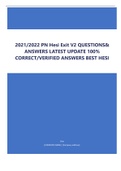College aantekeningen
Neuropsychology // Neuropsychologie (Vrije Universiteit) - Year 2, Period 1
- Instelling
- Vrije Universiteit
Hi! Need help with your upcoming neuropsychology exam? No problem! These notes include plenty of visuals and definitions to help you internalize ALL of the concepts discussed by Dr. Erik Scherder. I also added the bold definitions from the book so you wouldn't have to. Hope this helps and good lu...
[Meer zien]














